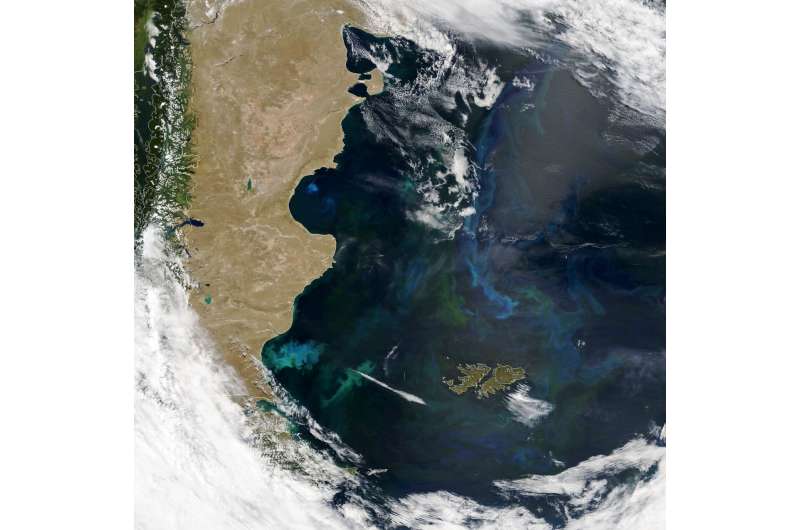
The Goldilocks zone typically refers to the habitable area around a star where conditions are right for the existence of liquid water and possibly life. But on Earth, the South Atlantic Ocean has its own kind of Goldilocks zone. In spring and summer, conditions in the Argentine Sea off Patagonia often become just right for phytoplankton, and populations of the plant-like organisms explode into enormous blooms.
In late 2020, satellite images started to show the colorful signature of phytoplankton blooms off the coast of Argentina and around the Falkland Islands (Islas Malvinas). Vivid greens and blues still swirled in the sea on January 5, 2021, when the Moderate Resolution Imaging Spectroradiometer (MODIS) on NASA's Terra satellite acquired this natural-color image (above).
The Operational Land Imager (OLI) on Landsat 8 acquired the image below on January 2, 2021. It shows a detailed view of phytoplankton in Grande Bay, off of Argentina's Santa Cruz province. Part of the Santa Cruz River is visible at the top-left.
Rivers like the Santa Cruz carry nutrients from the land and deliver them to the ocean, promoting phytoplankton growth. (Suspended sediment could be contributing some of the color visible in these images.) Another source of nutrients is dust from Patagonia, which strong westerly winds can carry offshore and drop on the ocean surface.
But phytoplankton blooms are also stimulated by the ocean's complex circulation patterns and abundant fronts—where separate water masses (with distinct temperatures, saltiness, and nutrients) meet. At the Brazil-Malvinas Confluence, for example, warm, saltier tropical waters flow south and meet the cooler, fresher waters flowing north from the Southern Ocean. Along a front, the rising of a less-dense water mass can carry nutrients up to the surface, where phytoplankton also have ample sunlight to fuel their growth.

Without a physical sample, it's not possible to say for sure which type of phytoplankton are present in these images. Scientists found dinoflagellates (Prorocentrum minimum) while collecting samples during an intense bloom in spring 2005; diatoms (Chaetocceros debilis) dominated a bloom in early summer 2003. Both phytoplankton groups tend to appear various shades of green in satellite images. In December 2008, scientists also found a dense bloom of coccolithophores (Emiliania huxleyi), which tend to turn the ocean a chalky green-blue.
Notice the color gradients across the images. Bright green areas could be a mix of dinoflagellates, diatoms, and coccolithophores; in the bluer areas, coccolithophores likely dominate. Coccolithophores can continue to grow in waters where iron has been depleted, whereas diatoms need both silicate and iron.
Whichever species were blooming, their abundance indicates the biological richness along Patagonia's continental shelf, which is the site of some of the world's richest fisheries.
Explore further
William M. Balch et al. Coccolithophore distributions of the North and South Atlantic Ocean, Deep Sea Research Part I: Oceanographic Research Papers (2019). DOI: 10.1016/j.dsr.2019.06.012
W. M. Balch et al. Surface biological, chemical, and optical properties of the Patagonian Shelf coccolithophore bloom, the brightest waters of the Great Calcite Belt, Limnology and Oceanography (2014). DOI: 10.4319/lo.2014.59.5.1715
José I. Carreto et al. Mycosporine-like amino acids and xanthophyll-cycle pigments favour a massive spring bloom development of the dinoflagellate Prorocentrum minimum in Grande Bay (Argentina), an ozone hole affected area, Journal of Marine Systems (2017). DOI: 10.1016/j.jmarsys.2017.10.004
Vivian A. Lutz et al. Primary production in the Argentine Sea during spring estimated by field and satellite models, Journal of Plankton Research (2009). DOI: 10.1093/plankt/fbp117
Alberto R. Piola et al. Physical Oceanography of the SW Atlantic Shelf: A Review, Plankton Ecology of the Southwestern Atlantic (2018). DOI: 10.1007/978-3-319-77869-3_2
Provided by NASA Earth Observatory
Citation: Phytoplankton factory in the Argentine Sea (2021, January 15) retrieved 15 January 2021 from https://ift.tt/35KMNnr
This document is subject to copyright. Apart from any fair dealing for the purpose of private study or research, no part may be reproduced without the written permission. The content is provided for information purposes only.
January 15, 2021 at 07:19PM
https://ift.tt/35KMNnr
Phytoplankton factory in the Argentine Sea - Phys.org
https://ift.tt/2CoSmg4
Sea
/cloudfront-us-east-2.images.arcpublishing.com/reuters/CZF6NULMVVMEXHOP7JK5BSPQUM.jpg)
No comments:
Post a Comment